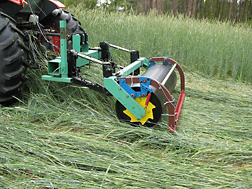 Close Topic Options
Close Topic OptionsTechniques for Managing Cover Crops
Techniques Managing Cover Crops - Sciences, Education, Art, Writing, UFO - Posted: 30th Oct, 2008 - 2:01pm
Techniques for Managing Cover Crops
Techniques for Managing Cover Crops
Agriculture Related Info
|
Read the magazine story to find out more. |
|
|
|
|
Managing Cover Crops with Rolling and Crimping Techniques
By Laura McGinnisSeptember 3, 2008
Rolling hay, rye and other cover crops could be the fastest way for some farmers to prepare their fields for planting. That's thanks to rolling machines--developed by Agricultural Research Service (ARS) scientists--that can quickly flatten mature, high-biomass cover crops such as rye.
Each roller consists of a long cylinder adorned with a series of thick, blunt, steel crimping bars, each about one-quarter-inch thick. As a standard tractor pulls the roller over the field, pressure from the bars flattens and damages the cover crop without cutting or uprooting it. Within three weeks, the rolled cover crop dries out, forming a mat of dead biomass into which farmers can plant cash crops.
Since 2001, ARS has been conducting research to find the best crimping roller design for conditions in the southeastern United States, and the benefits from this research are gaining recognition.
ARS scientists Ted Kornecki and Randy Raper and their colleagues at the agency's National Soil Dynamics Laboratory (NSDL) in Auburn, Ala., compared three different roller designs. The first roller has a traditional design with long, straight, horizontal bars. The second has diagonal bars that curve around the roller. The third has a smooth drum attached to a crimping bar that mashes the rye as the machine moves forward.
NSDL scientists, who developed the curved-bar and crimping roller designs, found that all three models killed enough rye--90 percent or more--to enable farmers to begin planting cash crops in the field within three weeks. The crimping-bar roller yielded the best results.
The scientists also found that the curved-bar and the crimping rollers provided smoother rides than the traditional straight-bar roller. Future studies will help scientists maximize the efficiency and comfort of these machines.
The one-pass process saves money, reduces soil erosion and runoff, helps control weeds, conserves water in the soil and decreases or eliminates the need for herbicides.
Read more about the research in the September 2008 issue of Agricultural Research magazine.
ARS is a scientific research agency of the U.S. Department of Agriculture.
Source: USDA Agricultural Research Service
 TOPIC: Techniques for Managing Cover Crops
TOPIC: Techniques for Managing Cover Crops The United States Department of Agriculture
The United States Department of Agriculture